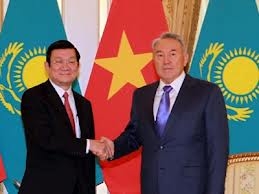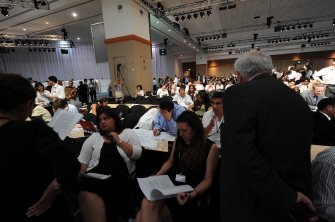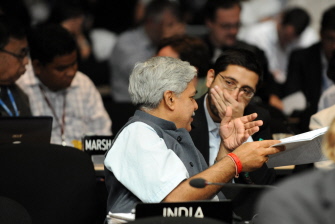Nations connect for common good
Vietnam and Singapore in August, 2010 celebrate the 36th anniversary of bilateral diplomatic relations. Singapore’s ambassador to Vietnam Simon Wong Wie Kuen tells VIR’s Lien Huong about the flourishing cooperation between the two nations during the past year and potential for future collaboration.
 Mr Simon Wong Wie Kuen |
Since coming into force in early 2006, the Connectivity Framework Agreement has achieved good progress in various sectors of economic cooperation.
Besides facilitating private sector investments by Singapore companies and contributing to Vietnam’s economic development, connectivity has enabled the strengthening of public sector cooperation through tourism exchanges, the provision of school twinning programmes, English language courses and student exchange programmes, the sharing of expertise on urban development, the provision of courses on e-government and information sharing on financial issues.
The recent 5th Connectivity Ministerial Meeting in Dalat City in March, 2010 saw both ministers acknowledging the excellent cooperation achieved thus far and reaffirmed the effectiveness of connectivity as the overarching bilateral economic cooperation framework. Since its implementation in early 2006, connectivity has successfully facilitated several private sector projects, and directly or indirectly contributed towards approximately $9 billion worth of Singapore’s registered investments into Vietnam.
Singapore’s private sector remains confident of Vietnam’s long-term economic prospects and has participated actively in various sectors in different parts of Vietnam. We are confident that bilateral economic relations between Vietnam and Singapore will continue to deepen and strengthen with the expansion into new areas of cooperation, such as cruise tourism and modern services.
In the fifth meeting on connectivity held in March 2010, the two countries agreed to expand bilateral cooperation in tourism and explore new opportunities for collaboration. Which specific measures have been developed by both sides since then to help accelerate bilateral cooperation in tourism?
The tourism agencies from both sides, the Singapore Tourism Board (STB) and Vietnam National Administration of Tourism (VNAT), continue to work closely to explore collaboration opportunities in cruise tourism. At the invitation of VNAT, STB led two study trips to assess the suitability of various ports in Vietnam for cruise tourism. A study trip to central and northern Vietnam was undertaken in July, 2009.
This led to the signing of a memorandum of understanding between Singapore Cruise Centre and Danang Port in March, 2010. The memorandum of understanding was a collaborative initiative, which offers Singapore Cruise Centre the opportunity to manage and operate the Danang Port upon completion of the supporting cruise infrastructure.
Last week, STB led another study trip to southern Vietnam to assess potential ports and identify the supporting infrastructure required for further cooperation on cruise tourism. Since the 5th connectivity meeting, our economic agency, International Enterprise Singapore (IE Singapore) has continued to actively promote investments into Vietnam through various channels including broad-based outreach seminars in Singapore and industry-focused business missions to Vietnam.
Recently, IE Singapore has organised and supported 14 business missions and seminar, both in-bound and out-bound, within a period of less than six months, to explore market opportunities in Vietnam. These promotional activities covered sectors such as urban infrastructure and services, hospitality, chemical and processing, education, and information and communication technology.
How has the Connectivity Framework Agreement and Vietnam-Singapore Industrial Park developments helped to encourage Singapore investments into Vietnam?
As an overarching platform for bilateral economic cooperation, the Connectivity Framework Agreement has successfully facilitated several private sector projects spanning across different sectors, and directly or indirectly contributed towards approximately $9 billion worth of Singapore’s registered investments into Vietnam.
Many Singapore companies from various sectors have benefited from the Vietnam-Singapore Connectivity Framework since it came into effect five years ago. This includes several significant investment projects by Singaporean companies in Vietnam such as the Vietnam-Singapore Industrial Parks (VSIP) led by SembCorp and its joint venture Vietnamese partner Becamex.
The first VSIP was first built in Binh Duong province in southern Vietnam in 1996. Following the success of VSIP I, VSIP II was launched in the same province in September, 2006. In 2007, VSIP III was launched in Bac Ninh province in northern Vietnam. These industrial parks focus on the development of industrial and export processing zones to facilitate Vietnam’s rapid economic development.
I am pleased to note that the VSIP consortium has recently launched its fourth project, an integrated township and industrial park in Haiphong in northern Vietnam. This project will focus on providing an attractive work-live-play environment, to cater to both the urban and industrial needs of the region.
To date, the total VSIP investments amount to more than $2.5 billion and have provided good job opportunities for more than 60,000 workers. Today, Singaporean companies with business and investment interests in Vietnam have expanded to cover an even wider range of industries, from real estate and industrial park development, to logistics, port development, healthcare and education.
Since early this year, the number of Singapore investors registering in trading and distribution flourished. Do you think there will be a shift of investment direction of Singaporean firms in Vietnam to trading and distribution to take advantage of the country’s opening of its retail market under World Trade Organization commitments?
Vietnam’s geographical and cultural proximity to Singapore and availability of labour makes it a choice market for Singaporean investors. To date, Singapore is ranked fifth in terms of registered investment capital in Vietnam, with a cumulative investment of $17.7 billion from 808 investment projects. Singapore companies remain interested in investing in various aspects of the Vietnamese economy, including the services and manufacturing sectors.
Vietnam this year took the chairmanship of ASEAN. How do you think it will help boost bilateral relations of Vietnam and Singapore in particular and among ASEAN countries in general?
Vietnam has been an effective chair of ASEAN this year. Under its stewardship, it has organised the key ASEAN ministerial and summit meetings well, including the recent successful 43rd AMM/PMC/17th ARF in Hanoi. Singapore is committed to working closely with the Vietnam chair to contribute towards concrete key deliverables on a range of issues including the evolving regional architecture and the ASEAN Connectivity Initiative.
Not only has Vietnam been effective in its consultations with the ASEAN member states on various issues and developments of the day, it has shown to be a strong representative for ASEAN in its capacity as ASEAN chair at international meetings such as the recent G20 Summit in Toronto.
Vietnam’s efforts have reinforced the reputation of Vietnam as a reliable and efficient member of ASEAN and are much appreciated by Singapore and other ASEAN partners.
What the stars mean:
★ Poor ★ ★ Promising ★★★ Good ★★★★ Very good ★★★★★ Exceptional
 Tag:
Tag:
Related Contents
Latest News
More News
- Mitsubishi Estate launches Logicross Hai Phong - a milestone in logistics evolution (November 20, 2024 | 14:32)
- Semiconductor workforce partnerships deliver industry-relevant training (November 20, 2024 | 10:58)
- German Quickpack to invest $31.7 million in Long An province (November 20, 2024 | 09:31)
- Foreign-invested enterprises drive logistics investment in the southeast region (November 20, 2024 | 09:27)
- Chile visit underscores trade benefits (November 19, 2024 | 10:00)
- Trump’s second term impacts sci-tech activities and industry 4.0 technologies (November 18, 2024 | 10:00)
- Vietnam eyes nuclear revival to bolster energy security (November 14, 2024 | 16:46)
- Kyokuyo completes $13.5 million seafood factory in Vietnam (November 14, 2024 | 12:19)
- VinFast receives $3.5 billion funding from Vingroup and Pham Nhat Vuong (November 14, 2024 | 06:38)
- Localities sprint to reach FDI targets (November 13, 2024 | 10:00)



















 Mobile Version
Mobile Version